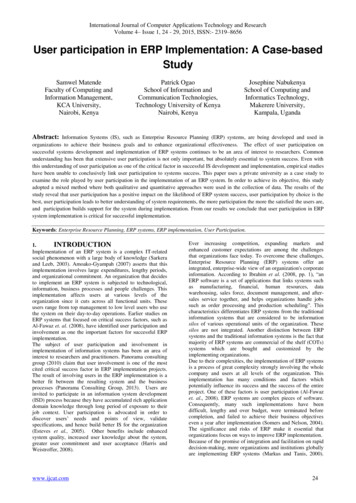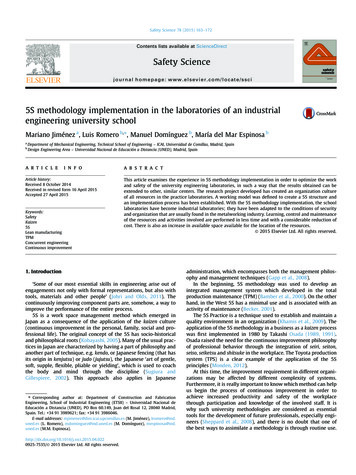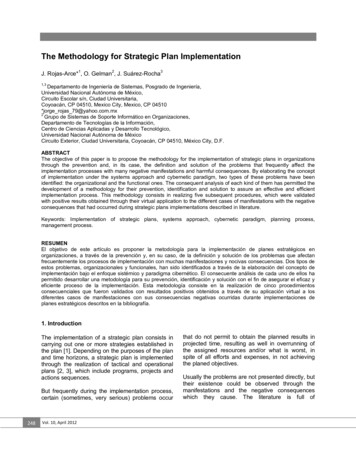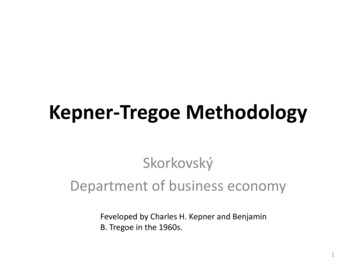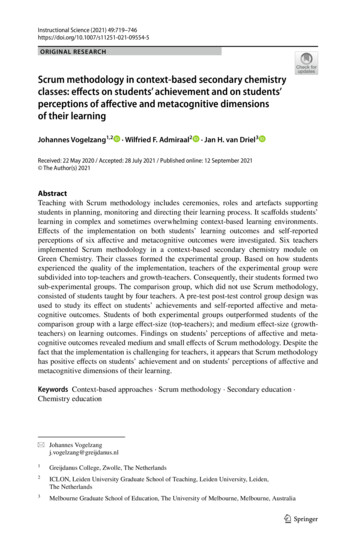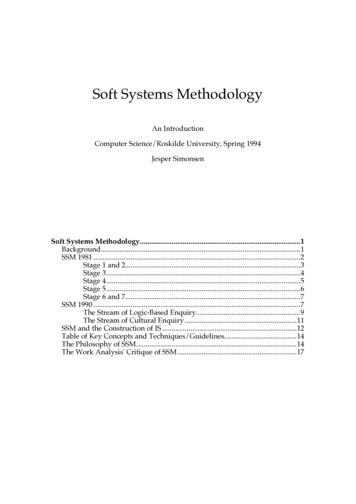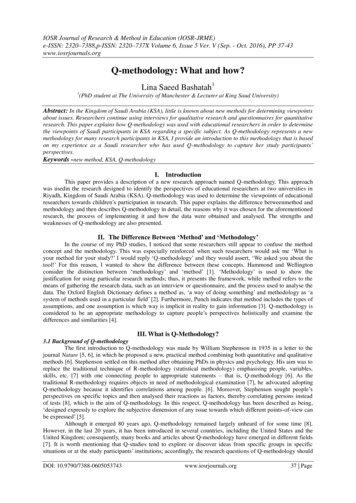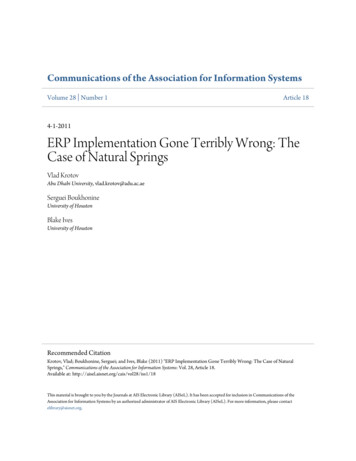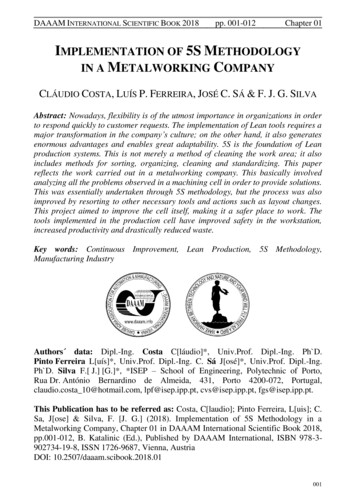
Transcription
DAAAM INTERNATIONAL SCIENTIFIC BOOK 2018pp. 001-012Chapter 01IMPLEMENTATION OF 5S METHODOLOGYIN A METALWORKING COMPANYCLÁUDIO COSTA, LUÍS P. FERREIRA, JOSÉ C. SÁ & F. J. G. SILVAAbstract: Nowadays, flexibility is of the utmost importance in organizations in orderto respond quickly to customer requests. The implementation of Lean tools requires amajor transformation in the company’s culture; on the other hand, it also generatesenormous advantages and enables great adaptability. 5S is the foundation of Leanproduction systems. This is not merely a method of cleaning the work area; it alsoincludes methods for sorting, organizing, cleaning and standardizing. This paperreflects the work carried out in a metalworking company. This basically involvedanalyzing all the problems observed in a machining cell in order to provide solutions.This was essentially undertaken through 5S methodology, but the process was alsoimproved by resorting to other necessary tools and actions such as layout changes.This project aimed to improve the cell itself, making it a safer place to work. Thetools implemented in the production cell have improved safety in the workstation,increased productivity and drastically reduced waste.Key words: Continuous Improvement, Lean Production, 5S Methodology,Manufacturing IndustryAuthors data: Dipl.-Ing. Costa C[láudio]*, Univ.Prof. Dipl.-Ing. Ph D.Pinto Ferreira L[uís]*, Univ.Prof. Dipl.-Ing. C. Sá J[osé]*, Univ.Prof. Dipl.-Ing.Ph D. Silva F.[ J.] [G.]*, *ISEP – School of Engineering, Polytechnic of Porto,Rua Dr. António Bernardino de Almeida, 431, Porto 4200-072, Portugal,claudio.costa 10@hotmail.com, lpf@isep.ipp.pt, cvs@isep.ipp.pt, fgs@isep.ipp.pt.This Publication has to be referred as: Costa, C[laudio]; Pinto Ferreira, L[uis]; C.Sa, J[ose] & Silva, F. [J. G.] (2018). Implementation of 5S Methodology in aMetalworking Company, Chapter 01 in DAAAM International Scientific Book 2018,pp.001-012, B. Katalinic (Ed.), Published by DAAAM International, ISBN 978-3902734-19-8, ISSN 1726-9687, Vienna, AustriaDOI: 10.2507/daaam.scibook.2018.01001
Costa, C.; Pinto Ferreira, L.; C. Sa, J. & Silva, F. J. G.: Implementation of 5S Meth.1. IntroductionOver the last two decades, the market has been subjected to continuous changeand has become increasingly competitive. During the course of the manufacturingprocess, companies have sought to improve quality, flexibility and delivery responsetime to customers by adopting the principles of Lean thinking (Rosemary et al. 2014).While this term has been widely acknowledged over the last years and in the mostdiverse areas, the underlying principle has always been the same: maximize thecustomer’s value and generate the least waste possible (Melton 2005,Mudhafar et al. 2017). Even though the Lean concept allows companies to developand improve their market position, they usually experience difficulties in changingand adapting to it (Magdalena & Beata 2017). The use and implementation of Leantools demand a great change in the company’s culture and strategy, which is usuallycounter-intuitive to people’s habits (Maia et al. 2011). One of these Lean tools is 5Smethodology, which started in Japan and was first developed by Hiroyuki Hirano inthe 80s. It includes five Japanese words (Patel & Thakkar 2014): Seiri (Sort), Seiton(Set in order), Seiso (Shine), Seiketsu (Standardize) and Shitsuke (Sustain).The work described in this article was developed at the company ManitowocCrane Group Portugal (MCG). Its main goal was to implement 5S methodology in amachine cell used in the welding process of cranes with a view to making theworkstation more efficient and safer. The article is divided into five sections: section1 consists of an introduction to the work at hand; section 2 presents a review ofliterature pertaining to 5S methodology; section 3 describes the methodology used tocarry out this study; section 4 presents all the practical work developed at thecompany, firstly dealing with the cell in question, and subsequently, with theproblems detected and the improvements implemented in the process; lastly, section5 provides the conclusions of the work developed.2. Literature Review5S methodology constitutes the basis for the implementation of anyimprovement activity. It consists of a visual cleaning technique which presupposes acompliance with five activities in order to create a workstation which will be suitablefor visual control and Lean practices (Melton 2005). The method allows for theimprovement of the system’s performance since it helps to reduce the time requiredto add value; this, in turn, enables an increase in productivity and enhances productquality (Omogbai & Salonitis 2017). 5S is the acronym of five Japanese words(Mariano et al. 2015) which represent the five stages inherent to this methodology: 1S – Seiri (Sort): The objective is to classify all the unnecessary items andsegregate those which are not useful on a daily basis (Filip & Marascu-Klein2015). 2S – Seiton (Straighten): The principle is that defining a location for all goodswithin the work area, so that these are always stored in the same place(Ramdass 2015).002
DAAAM INTERNATIONAL SCIENTIFIC BOOK 2018pp. 001-012Chapter 01 3S – Seiso (Shine): This implies cleaning the entire area and equipment so thatthe best hygiene and safety conditions prevail in the workstation(Filip & Marascu-Klein 2015). 4S – Seiketsu (Standardize): Standardization constitutes the first step inmaintaining the first 3Ss implemented. The objective is to create standardprocedures throughout the operation, so that operators can always perform theirdaily tasks in the same manner (HungLin 2011). 5S – Shitsuke (Sustain): The first three phases are operational; the fourthmaintains the state reached through the previous phases, and the fifth phasefosters a commitment to continuous improvement (Mariano et al. 2015).The 5S program promotes many important benefits for the organization. Themost noteworthy of these are: the maximization of efficiency; the reduction ofdefects; better safety in the workstation and an improvement in the worker’s lifequality and morale (HungLin 2011). Countless scientific articles have presented caseswhere 5S methodology was implemented and produced extremely positive results. Inthe small-scale manufacturing industry, various authors have demonstrated that, atdifferent intervention intervals, this practice generates several benefits such as: betterspace management; increase in productivity; reduction in the time required to findobjects; prevention of tool loss (Ashraf et al. 2017); less waste; improvements in thework environment (Devkar & Raut 2016), in safety and productivity, as well asefficiency and cleanliness. Besides these, the system also promotes strong workethics, since there is a greater commitment by operators to maintain good practices(Agrahari et al. 2015).Other companies in varied industry sectors such as the areas of textiles,technology, automotive and metallurgy have also embraced this methodology. Inthese cases, the results have allowed one to conclude that there are improvements incleanliness, environmental performance, health, safety (Rahman et al. 2010) andresponse to the customer (HungLin 2011). It has also been proved that thismethodology can be sustained if the operators’ motivation is assured (Patil et al.2016). Nevertheless, the advantages derived from 5S implementation are notrestricted to the manufacturing industry alone. On analyzing the interventionsundertaken in the most diverse service industries, one can state that the ensuingimprovements were clearly noticeable. A university laboratory promoted betterorganization and was thus able to improve safety, reduce the time wasted on objectseeking, as well as enhance the environment and workflow (Mallick et al. 2013).Another laboratory, in the pharmaceutical area, was also able to reduce costs andincrease free space (Mariano et al. 2015). In health care facilities across variousworldwide hospital sectors, improvements were observed in parameters such assafety, efficiency and patient centralization. If the low costs of implementation areadded, it can be concluded that this practice should always be the starting point forany attempt at quality improvement in the health sector (Kanamori et al. 2016). It hasthus been demonstrated that, regardless of the type of work undertaken, performanceis undoubtedly improved through 5S practices (Ghodrati & Zulkifli 2013).003
Costa, C.; Pinto Ferreira, L.; C. Sa, J. & Silva, F. J. G.: Implementation of 5S Meth.However, despite the fact that the methodology supports a company’s objectiveto achieve better performance and productivity, results have also pointed out someconcerns. The most significant of these lies on the lack of communication andcooperation by senior management, which constitutes a huge hurdle and can only beaddressed through continuous training (Ghodrati & Zulkifli 2012).3. MethodologyThe methodology used to carry out this work consisted of several stages. In thefirst stage, one studied the entire productive process by means of data collection fromthe factory floor and by consulting MCG’s internal documentation. The second phaseconsisted of undertaking a review of literature related to analysis methods and tools,as well as the improvement of productive processes. This was supported by scientificarticles, theses and books pertaining to 5S methodology. The purpose here was tosustain the empirical investigation presented in a coherent manner. In the next stage,the third, one proceeded with the mapping of the problems detected and of all theproposed improvement measures. It was during this phase that one also drafted a planof the work to be done and gathered all the required documentation. The final phaseconsisted of the improvements implementation with a view to eliminating theproblems found and refining the productive process.4. Implementation of 5S Methodology in a Machining CellThis cell comprises two pieces of work equipment which carry out themachining process, and are known as Caser (see Figure 1). The process consists ofmechanically cutting/roughing parts in order to obtain surfaces, holes, vertexes oredges, which are extremely accurate in measurement and are superficially coatedwith a high quality finish.Fig. 1. Machining cell4.1 Identification of ProblemsBefore in situ work was initiated, the team met for brief training during which onepresented an explanation of the principles to be implemented. After this trainingsession, the team visited and provided a critical analysis of the machining cell inorder to prepare a course of action for the activity. Table 1 presents the problemsidentified in the work cell, as well as the respective solutions proposed.004
DAAAM INTERNATIONAL SCIENTIFIC BOOK 2018Problems IdentifiedUnnecessary or obsolete toolsInadequate support facilitiesInappropriate workbenchesRather disorganized cellTools scattered across theworkspaceWorn-out floor surfaceIndividual protection equipment(IPE) hanging on the workbenchDisorder of auxiliary toolsUnidentified oil depositsWork and support facilities donot comply with the colourstandardCement floor (absorbs liquids)No cleaning material in the cellNo cell cleaning routinespp. 001-012SolutionsApplication of the RED TAGmethod (identification card)Correction of support facilitiesImprovement of benchesDevelopment of a new layoutCreation of a Tool Shadowboard(board for hanging up tools)Placement of floor markingsChapter 01Stage of 5SMethodology1S2S2S2S2S2SProvision of lockers for IPE2SProvision of a tool trolleyIdentification of oil deposits2S2SExecution of painting in accordancewith the MCG standard2SPainting of the pavement surfaceProvision of a CleaningShadowboardCreation of a 5S Area Board (tohold documents)2S3S3STab. 1. Identification of the problems and the respective solutions proposals for themachining cell.4.2 Stages in 5S MethodologyThe 5S in situ implementation was carried out by means of a Kaizen activity. Amultidisciplinary team was established, which purpose was to implement the first 3Sson the machining tool, at the most reduced cost and time, and respecting the 5Sconcept. The first rule is “step-by-step” implementation, namely never proceeding tothe following “S” without meeting all of the previous “S” requirements.4.2.1 The 1S Stage (Simplification)Many of the tools in the machine cell were found to be obsolete, damaged or simplyuseless for the work to be undertaken. Besides these tools, the workbenches andcupboards were also unsuitable for the work being done (see Figures 2A and 2B).The classification and separation of material, tools and unnecessary support itemsallowed for an increase in free space in the cell, thus making the workstation tidierand safer. In addition, the fact that only the really necessary items are now found inthe area, reduces both confusion and time spent looking for the required tools.All of the tools which were not essential for daily work were identified bymeans of RED TAG identification (see Figure 2C).005
Costa, C.; Pinto Ferreira, L.; C. Sa, J. & Silva, F. J. G.: Implementation of 5S Meth.Fig. 2. [A] Inadequate workbench; [B] Excessive number of cupboards; [C] REDTAG.4.2.2 The 2S Stage (Organization)This phase began with the reutilization of all the existing structures in the machiningcell so that the support facilities were renovated and made more useful for theoperators using them, thus minimizing expenses.The new workbench is far more efficient and the creation of a Shadowboardenables operators not to waste time looking for the tools and lifting accessories (seeFigures 3A, 3B and 3C).Fig. 3. [A] Previous workbench; [B] New workbench; [C] Shadowboard.The auxiliary Caser cutting tools were mixed up and disorganized (seeFigure 4A), which caused workers to spend too much time looking for tools; in thecase of new operators, this also often led to the choice of the wrong tools. In addition,the storage method constituted a safety risk, and handling caused sometimes cuts tothe hands.Changes were made to the trolley in order to organize tools according to size,identifying and positioning them vertically (see Figure 4B). In addition to this trolley,one was able to transform one of the unused cupboards and built another, which ismore ergonomic, safer, more practical and mobile, thus ensuring a place for each tool(Figure 4C).These improvements enable both the elimination of error as well as greaterspeed in the choice of the correct tool. The fact that these are now positionedvertically/diagonally makes the work safer and allows the handling of tools to bemore ergonomic and less tiring.006
DAAAM INTERNATIONAL SCIENTIFIC BOOK 2018pp. 001-012Chapter 01Fig. 4. [A] and [B] Before and after the tool trolley; [C] New tool trolley.Other adaptations were carried out, such as the division of a cupboard into smallindividual compartments, similar to lockers, where operators can keep their IPE(Individual Protective Equipment) and not leave it scattered around the work area asbefore. Another example was the adjustment of a structure, which was initially usedto store the Caser cutting tool when this was not in use. Wheels and a safety devicewere added to the structure so that it could be used both for storage, as well as for thetransportation of tools; thus, operators will no longer have to wait for the overheadcrane, which can take up to 15 minutes. This task therefore became faster, morepractical and safer. In the oils section, none of the products was identified. Thisinvariably led to time being spent in the singling out of identification labels, whichwere very often illegible. With regard to the lifting accessories, all of these werescattered on top of the oil collection or deposit tanks (see figure 5A). These situationswere solved by adding identification labels to all the oils (see figure 5B) and bybuilding a shadowboard. One thus reduced both the chances of making mistakes andalso enabled an increase in task execution speed (figure 5C).Fig. 5. [A] Untidiness on the oil tanks; [B] Identification of tanks; [C] Shadowboardfor container lifting accessories.The final task consisted of developing a new layout and placing all the floormarkings. Due to these changes (see figure 6A), the distances covered by operatorswhen carrying out everyday tasks were reduced; the transport of materials alsobecame smoother and more efficient. All of the work and support structures werepainted in accordance with the Manitowoc Colour Standard, and the floor pavementsurface was painted in grey to reduce the absorption of oils and facilitate cleaning byoperators. In addition, risk areas were identified by means of safety markings (seefigure 6B).007
Costa, C.; Pinto Ferreira, L.; C. Sa, J. & Silva, F. J. G.: Implementation of 5S Meth.Fig. 6. [A] New layout; [B] Marking of structures and of the safety areas.4.2.3 The 3S Stage (Cleaning)The machining cell looked rather disorganized and dirty. Besides generating a largequantity of filings due to the cutting of pieces, the operation itself discharges asubstantial amount of oil onto the area surrounding the machine, which results fromthe lubrication required.This not only causes a negative impression but also makes the cell dangerous foroperators. Consequently, and in addition to the Checklist of basic daily taskspresented in the 5S table applied to the cell (see figure 7A), one built a shadowboardduring this stage; this is where all the tools required for this routine cleaningprocedure are now stored (see figure 7B).Fig. 7. [A] 5S Area Board; [B] Cleaning shadowboard.4.2.4 The 4S Stage (Standardization)In order to maintain the first 3Ss, access must be ensured to document support: thispresents all the procedures and principles to follow, and sets out the routines whichare to be fully implemented in the operators’ professional practice. This consists ofthree very important parts (see Table 2).008
DAAAM INTERNATIONAL SCIENTIFIC BOOK 2018Documentationpp. 001-012Chapter 01Descripton Visible on the 5S Table Document Support 5S WheelList of RED TAG objectsBlank RED TAGs (to be filled in)Audit FormsPlan of Actions5S ProcedureRED TAG FlowchartDefinition of Standard ColoursStandard Procedure for IdentificationInstructions for the completion of the 5S WheelRED TAG Activity – to foster a mindset in which the operatorwill ask himself whether the whole tools available at theworkstation are necessary.Established Shadowboards – Storage for support tools and cleaning utensilsRoutineson standardized toolboards. Cleaning Checklist - The operator has a checklist to provideinformation as to what must be used, where and when, in orderto keep his workstation clean and tidy.Tab. 2. Essential features of standardization.4.2.5. The 5S Stage (Sustain)In association to the routines created, visual tools and documents will not, inthemselves, sustain 5S. Although they provide great assistance, it is the operator whomust incorporate some of the fundamental values involved, such as: self-discipline,politeness, respect, commitment, pride and the sense of a job well done. Indeed, whenoperators working at a specific workstation participate actively in a Kaizen activity,this automatically gives them added responsibility since they now participate in allthe decisions made by the team.They will subsequently have the responsibility of maintaining their workstationsin line with the 5Ss implemented. The 5S audits also constitute an important part inthis process and take place monthly, in all of the 5S Areas. By providing anassessment which relates to the 5S Wheel (see figure 7A), these audits show how thenext “S” can be reached by using the action plan.4.3. Results AnalysisAn analysis of the work undertaken has enabled one to visualize some of the potentialaspects of 5S methodology. This technique has allowed for the simple solution ofproblems, without great investments, but which have produced an extremely positiveimpact. By implementing the proposals, one was able to achieve the results describedin Table 3.009
Costa, C.; Pinto Ferreira, L.; C. Sa, J. & Silva, F. J. G.: Implementation of 5S Meth.5SStageAnalysis of Results1S More free space in the cell - elimination of unnecessary items; Improved use of the workstation – greater speed in finding objects; Less chance of losing tools.2S Workbench is more ergonomic and safer;Fewer mistakes in the selection of Caser auxiliary tools;Greater speed and safety in tool use;Handling of tools is less tiring for the operator;Better storage – more space to keep tools and IPE;Greater autonomy (reduction of waiting time);Improved layout organization;Less distance covered by operators and materials;Waste material, labour and time reduced to the minimum.3S Greater cleaning efficiency – organized tools;Easier verification – checklist with routines;Safer cell – elimination of accident sources;Better visual aspect;Improvement of the work environment. Improved company standards; Improvement of internal communication; Improvement in human relations (closer ties between senior4S and 5Smanagement and the shop floor workers); Increase in workers’ pride and morale; Increase in productivity.Tab. 3. Results achieved.5. Discussion and ConclusionsThe work presented has produced remarkable gains, both in the production area aswell as in those of quality and safety. Owing to the nature of the improvementsundertaken, most of which were organizational and visual, it is difficult to measurethe results obtained in an accurate manner. This is a limitation of this work.However, by observing the work carried out, one was able to perceive that whenthe cleaning and organization processes are increasingly executed, the operators’performance and productivity are also enhanced. This is a direct consequence ofworkers being able to find everything faster, without making mistakes, in a moreergonomic and safer manner, thus executing their tasks more effectively. The resultof these changes is reflected in minimum levels of waste material, as well as inreduced labour and times which, in turn, lead to a greater reliability of delivery datesand, ultimately, customer satisfaction.010
DAAAM INTERNATIONAL SCIENTIFIC BOOK 2018pp. 001-012Chapter 01However, the advantages are not merely restricted to the visual aspects and tothe mathematics of productive efficiency. Through these improvements, one alsoobserved higher levels of morale and pride in the workers. There was, furthermore, avisible improvement in the work environment and in internal communication/humanrelations. The existence of more room, better storage organization, as well as severalother changes, all contributed to making the workstations safer by limiting thechances of accidents. It is undeniable that all of these aspects are essential toeveryone’s sense of wellbeing. There is great relevance in highlighting that theseparameters are of great importance in a philosophy of continuous improvement: onlyby having motivated staff can one possibly hope to achieve positive results. One mustalso highlight the importance of promoting training activities to discuss these Leantechniques with operators; this is fundamental to the process since workers are,unquestionably, the drivers of change.It is also expected that in the future, through discipline and a compliance withthe proceedings for the 4S and 5S stages, the company will achieve a greater capacityto criticize and organize, so that the cells will not return to their previous state ofneglect.6. ReferencesAb Rahman, M.N., Khamis, N.K., Zain, R.M., Deros, B.M. and Mahmood, W.H.W.,(2010). Implementation of 5S Practices in the Manufacturing Companies: A CaseStudy, American Journal of Applied Sciences 7 (8): 1182-1189.Agrahari, R.S., Dangle, P.A., Chandratre, K.V., (2015). Implementation of 5Smethodology in the small scale industry: A case study, International Journal ofScientific & Technology Research Volume 4, Issue 04, pp. 180-187.Devkar, R. and Raut, N., (2016). Methodology for ‘5S’ implementation in a smallscale manufacturing industry, IJISET - International Journal of Innovative Science,Engineering & Technology, Vol. 4, Issue 3, pp. 137-141.Filip, F.C. & Marascu-Klein, V. (2015), The 5S lean method as a tool of industrialmanagement performances. IOP Conf. Series: Materials Science and Engineering 95.Ghodrati, A. and Zulkifli, N., (2012). A Review on 5S Implementation in Industrialand Business Organizations, IOSR Journal of Business and Management, Volume 5,Issue 3, pp. 11-13.Ghodrati, A. and Zulkifli, N., (2013). The Impact of 5S Implementation on IndustrialOrganizations Performance, International Journal of Business and ManagementInvention, Vol. 2, Issue 3, pp. 43-49.HungLin, Chi (2011). 5S implementation in Wang Cheng Industry ManufacturingFactory in Taiwan, A Research Paper Submitted in Partial Fullfillement of theRequirements for the Master of Science Degree in Technology Management,University of Wisconsin-Stout.011
Costa, C.; Pinto Ferreira, L.; C. Sa, J. & Silva, F. J. G.: Implementation of 5S Meth.Kanamori, S., Shibanuma, A. and Jimba, M. (2016). Applicability of the 5Smanagement method for quality improvement in health- care facilities: a review,Tropical Medicine and Health 44:21.Magdalena K. Wyrwicka and Beata Mrugalska (2017). Mirages of LeanManufacturing in Practice, Procedia Engineering 182, 780-785.Maia, L.C., Alves, A.C. & Leão, C.P. (2011), Metodologias para implementar LeanProduction: uma revisão crítica de literatura. Universidade do Minho, Escola deEngenharia, Departamento de Produção e Sistemas.Mallick, A., Kaur, A. and Patra, M., (2013). Implementation of 5S in PharmaceuticalLaboratory, International Journal of Pharmaceutical Research and Bio-science, Vol.2(1): 96-103.Mariano Jiménez, Luis Romero, Manuel Dominguez, Maria del Mar Espinosa(2015). 5S methodology implementation in the laboratories of an industrialengineering university school, Safety Science 78: 163-172.Melton, T. (2005), The Benefits of Lean Manufacturing: What Lean Thinking has tooffer the Process Industries. Chemical Engineering Research and Design 83(A6),662-673.Mudhafar Alefari, Konstantinos Salonitis, Yuchun Xu (2017). The role of leadershipin implementing lean manufacturing, Procedia CIRP 63: 756-761.Omogbai, O. & Salonitis, K. (2017), The implementation of 5S lean tool usingsystem dynamics approach. Procedia CIRP 60, 380-385.Patil, S., Sapkal, A. and Sutar, M. (2016). Execute 5S Methodology in Small ScaleIndustry: A Case Study, International Journal of Research in Advent Technology,Vol.4, No.3, pp. 47-52.Patel, Vipulkumar C. & Thakkar, Hemant (2014), A Case Study: 5S Implementationin Ceramics Manufacturing Company. Bonfring International Journal of IndustrialEngineering and Management Science, Vol. 4, No. 3.Ramdass, Kem (2015). Integrating 5S Principles with Process Improvement: A casestudy, Proceedings of PICMET’15: Management of the Technology Age.Rosemary R. Fullerton, Frances A. Kennedy, Sally K. Widener (2014), Leanmanufacturing and firm performance: The incremental contribution of leanmanagement accounting practices. Journal of Operations Management 32, 414-428.Sk. Ashraf, R. B., Rashid, M.M. and Dr. Rashid, A R M H., (2017). Implementationof 5S Methodology in a Food & Beverage Industry: A Case Study, InternationalResearch Journal of Engineering and Technology, Vol. 04 Issue: 03, pp. 1791-1796.012
DAAAM INTERNATIONAL SCIENTIFIC BOOK 2018 pp. 001-012 Chapter 01 IMPLEMENTATION OF 5S METHODOLOGY IN A METALWORKING COMPANY CLÁUDIO COSTA, LUÍS P. FERREIRA, JOSÉ C. SÁ & F. J. G. SILVA Abstract: Nowadays, flexibility is of the utmost importance in organizations in order to respond quickly to customer requests. The implementation of Lean tools requires a

